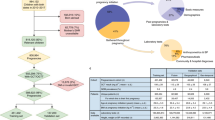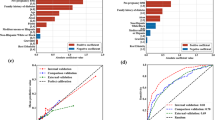Abstract
Aims
Women with gestational diabetes mellitus (GDM) have an increased risk of diabetes postpartum. We developed a score to predict the long-term risk of postpartum diabetes using clinical and anamnestic variables recorded during or shortly after delivery.
Methods
Data from 257 GDM women who were prospectively followed for diabetes outcome over 20 years of follow-up were used to develop and validate the risk score. Participants were divided into training and test sets. The risk score was calculated using Lasso Cox regression and divided into four risk categories, and its prediction performance was assessed in the test set.
Results
Postpartum diabetes developed in 110 women. The computed training set risk score of 5 × body mass index in early pregnancy (per kg/m2) + 132 if GDM was treated with insulin (otherwise 0) + 44 if the woman had a family history of diabetes (otherwise 0) − 35 if the woman lactated (otherwise 0) had R 2 values of 0.23, 0.25, and 0.33 at 5, 10, and 15 years postpartum, respectively, and a C-Index of 0.75. Application of the risk score in the test set resulted in observed risk of postpartum diabetes at 5 years of 11 % for low risk scores ≤140, 29 % for scores 141–220, 64 % for scores 221–300, and 80 % for scores >300.
Conclusions
The derived risk score is easy to calculate, allows accurate prediction of GDM-related postpartum diabetes, and may thus be a useful prediction tool for clinicians and general practitioners.


Similar content being viewed by others
References
American Diabetes Association (2011) Standards of medical care in diabetes—2011. Diabetes Care 34(Suppl 1):S11–S61. doi:10.2337/dc11-S011
Bellamy L, Casas JP, Hingorani AD, Williams D (2009) Type 2 diabetes mellitus after gestational diabetes: a systematic review and meta-analysis. Lancet 373(9677):1773–1779. doi:10.1016/S0140-6736(09)60731-5
Kim C, Newton KM, Knopp RH (2002) Gestational diabetes and the incidence of type 2 diabetes: a systematic review. Diabetes Care 25(10):1862–1868
Ziegler AG, Wallner M, Kaiser I et al (2012) Long-term protective effect of lactation on the development of type 2 diabetes in women with recent gestational diabetes mellitus. Diabetes 61(12):3167–3171. doi:10.2337/db12-0393
Füchtenbusch M, Ferber K, Standl E, Ziegler A-G (1997) Prediction of type 1 diabetes postpartum in patients with gestational diabetes mellitus by combined islet cell autoantibody screening: a prospective multicenter study. Diabetes 46(9):1459–1467
Löbner K, Knopff A, Baumgarten A et al (2006) Predictors of postpartum diabetes in women with gestational diabetes mellitus. Diabetes 55(3):792–797
Henry OA, Beischer NA (1991) 11 Long-term implications of gestational diabetes for the mother. Baillière’s Clin Obstet Gynaecol 5(2):461–483. doi:10.1016/S0950-3552(05)80107-5
Tibshirani R (1997) The lasso method for variable selection in the Cox model. Stat Med 16(4):385–395
Gerds TA, Cai T, Schumacher M (2008) The performance of risk prediction models. Biom J 50(4):457–479. doi:10.1002/bimj.200810443
Gerds TA, Kattan MW, Schumacher M, Yu C (2013) Estimating a time-dependent concordance index for survival prediction models with covariate dependent censoring. Stat Med 32(13):2173–2184. doi:10.1002/sim.5681
Steyerberg E (2010) Clinical prediction models: a practical approach to development, validation, and updating. Springer, New York
Team RC (2014) R: a language and environment for statistical computing. R Foundation for Statistical Computing, Vienna
Lee AJ, Hiscock RJ, Wein P, Walker SP, Permezel M (2007) Gestational diabetes mellitus: clinical predictors and long-term risk of developing type 2 diabetes: a retrospective cohort study using survival analysis. Diabetes Care 30(4):878–883. doi:10.2337/dc06-1816
Stuebe AM, Rich-Edwards JW, Willett WC, Manson JE, Michels KB (2005) Duration of lactation and incidence of type 2 diabetes. JAMA 294(20):2601–2610. doi:10.1001/jama.294.20.2601
Kwak SH, Choi SH, Kim K et al (2013) Prediction of type 2 diabetes in women with a history of gestational diabetes using a genetic risk score. Diabetologia 56(12):2556–2563. doi:10.1007/s00125-013-3059-x
Noctor E, Crowe C, Carmody LA et al (2015) ATLANTIC-DIP: prevalence of metabolic syndrome and insulin resistance in women with previous gestational diabetes mellitus by International Association of Diabetes in Pregnancy Study Groups criteria. Acta Diabetol 52(1):153–160. doi:10.1007/s00592-014-0621-z
Hippisley-Cox J, Coupland C (2011) Development and validation of risk prediction algorithm (QThrombosis) to estimate future risk of venous thromboembolism: prospective cohort study. BMJ 343:d4656. doi:10.1136/bmj.d4656
Barden A, Singh R, Walters B, Phillips M, Beilin LJ (2013) A simple scoring method using cardiometabolic risk measurements in pregnancy to determine 10-year risk of type 2 diabetes in women with gestational diabetes. Nutr Diabetes 3(6):e72. doi:10.1038/nutd.2013.15
Coustan DR, Carpenter MW, O’Sullivan PS, Carr SR (1993) Gestational diabetes: predictors of subsequent disordered glucose metabolism. Am J Obstet Gynecol 168(4):1139–1144. doi:10.1016/0002-9378(93)90358-P
Damm P, Kühl C, Bertelsen A, Mølsted-Pedersen L (1992) Predictive factors for the development of diabetes in women with previous gestational diabetes mellitus. Am J Obstet Gynecol 167(3):607–616. doi:10.1016/S0002-9378(11)91559-2
Schaefer-Graf UM, Buchanan TA, Xiang AH, Peters RK, Kjos SL (2002) Clinical predictors for a high risk for the development of diabetes mellitus in the early puerperium in women with recent gestational diabetes mellitus. Am J Obstet Gynecol 186(4):751–756. doi:10.1067/mob.2002.121895
de Seymour JV, Conlon CA, Sulek K et al (2014) Early pregnancy metabolite profiling discovers a potential biomarker for the subsequent development of gestational diabetes mellitus. Acta Diabetol 51(5):887–890. doi:10.1007/s00592-014-0626-7
Ratner RE (2007) Prevention of type 2 diabetes in women with previous gestational diabetes. Diabetes Care 30(Supplement_2):S242–S245. doi:10.2337/dc07-s223
Baptiste-Roberts K, Barone BB, Gary TL et al (2009) Risk factors for type 2 diabetes among women with gestational diabetes: a systematic review. Am J Med 122(3):207.e204–214.e204. doi:10.1016/j.amjmed.2008.09.034
Kahn HS, Cheng YJ, Thompson TJ, Imperatore G, Gregg EW (2009) Two risk-scoring systems for predicting incident diabetes mellitus in US adults age 45 to 64 years. Ann Intern Med 150(11):741–751
Acknowledgments
The authors thank Annette Knopff (Institute of Diabetes Research, Helmholtz Zentrum München), Sandra Hummel (Institute of Diabetes Research, Helmholtz Zentrum München), Melanie Bunk (Forschergruppe Diabetes, Klinikum rechts der Isar, Technische Universität München), and Martin Füchtenbusch (Forschergruppe Diabetes, Klinikum rechts der Isar, Technische Universität München) for their help in recruitment and follow-up and for their expert technical assistance. This work is partly based on the dissertation of Meike Köhler at the Ludwig-Maximilians-Universität München.
Funding
This study was supported by grants from the Helmholtz International Research Group (HIRG-0018) and the German Federal Ministry of Education and Research (BMBF) to the German Centre for Diabetes Research (DZD e.V.) and to the German Competence Net for Diabetes Mellitus (01GI0805).
Author contributions
MK analyzed the data and wrote the first and final drafts of the manuscript together with AB. AGZ designed the study, conceived the analysis, and critically revised the manuscript.
Author information
Authors and Affiliations
Corresponding author
Ethics declarations
Conflict of interest
The authors declare that they have no conflicts of interest.
Human and animal rights disclosure
All procedures followed were in accordance with the ethical standards of the responsible committee on human experimentation (institutional and national) and with the Helsinki Declaration of 1975, as revised in 2008 (5). The study was approved by the ethics committee of Bavaria, Germany (Bayerische Landesärztekammer Nr. 95357).
Informed consent disclosure
All patients gave written informed consent to participate in the study.
Additional information
Managed by Massimo Porta.
Electronic supplementary material
Below is the link to the electronic supplementary material.
Rights and permissions
About this article
Cite this article
Köhler, M., Ziegler, A.G. & Beyerlein, A. Development of a simple tool to predict the risk of postpartum diabetes in women with gestational diabetes mellitus. Acta Diabetol 53, 433–437 (2016). https://doi.org/10.1007/s00592-015-0814-0
Received:
Accepted:
Published:
Issue Date:
DOI: https://doi.org/10.1007/s00592-015-0814-0




